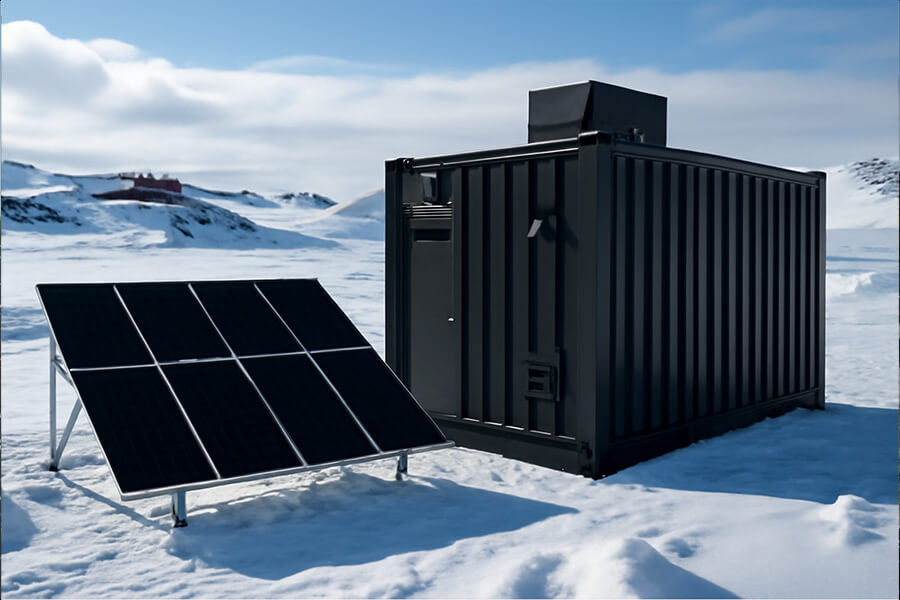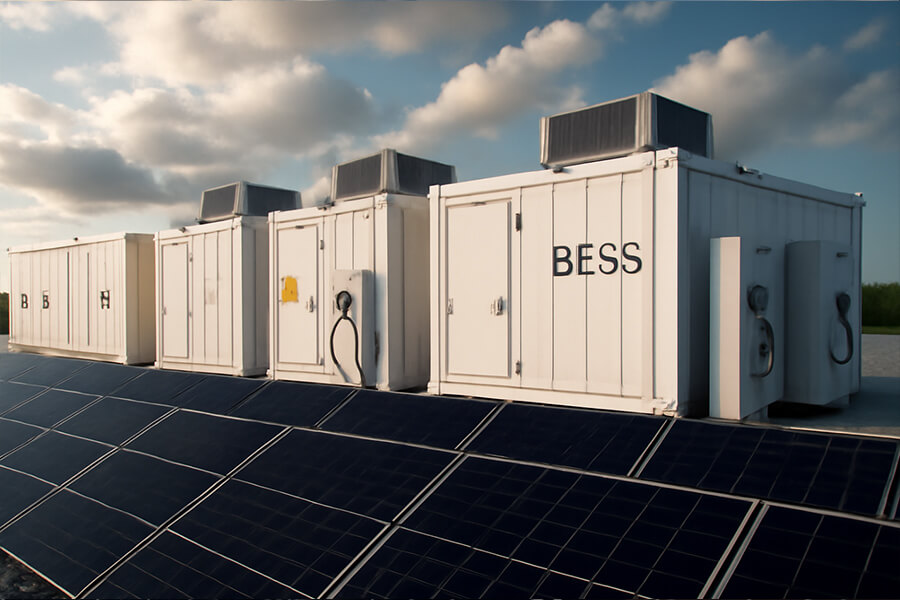Gas peaker plants are the couch potatoes of the grid: sluggish, expensive, and belching emissions for rare peak demand moments. Enter BESS Container Peaker Plant solutions – the agile, zero-emission sidekicks turbocharging (or replacing) these relics. In 2025, augmenting peakers with battery storage slashes costs 40%, cuts CO₂ by 70%, and responds faster than a caffeinated electron. Discover how this dynamic duo is rescuing grids from ‘peaker panic’ – no fossil-fueled yoga pants required

The “Couch Potato” Power Plant: Why Gas Peakers Need an Intervention
Picture your grid’s “emergency responder” – the gas peaker plant – as a firefighter who sleeps 95% of the year, chugs premium fuel like it’s an all-day happy hour, and leaves a carbon footprint bigger than Godzilla’s abandoned flip-flop1. Inefficient? Oh, yes. Eco-unfriendly? You bet. In 2025, with grids screaming for flexibility, this ’90s relic isn’t just outdated—it’s an expensive, belching dinosaur at a climate-conscious tea party.
The Efficiency Train Wreck
While efficient combined-cycle gas turbines (CCGTs) achieve 60% efficiency, peakers operate at a pathetic 30-45%2. Why? They’re designed to ramp up fast, not sip fuel daintily. It’s like comparing a Prius to a drag racer with a leaky gas tank.
Costs That’ll Make Your Wallet Weep
Peakers charge premium rates for their “on-demand” service. Check the 2025 price tags3:
| Power Source | Avg. Cost per MWh | Startup Time |
|---|---|---|
| Gas Peaker | 225 | 10-30 min |
| Solar + BESS | 55 | <1 sec |
| CCGT (Baseload) | 90 | 1-4 hours |
Source: Lazard’s Levelized Cost of Energy Analysis v18.0 (2024)
Translation: Paying peakers is like hiring a Formula 1 car to fetch groceries.
Emissions: The Silent (But Deadly) Party Guest
When peakers finally wake up, they really make their presence known:
– **CO2 Emissions**: **0.6 – 0.8 tons/MWh** (vs. 0.3-0.4 tons for CCGTs)[^4] – **Nitrogen Oxides (NOx)**: **20-50x higher** than solar/BESS during operation[^5] – **Water Consumption**: **100-300 gallons/MWh** (BESS: *sips tea quietly*)[^6]
In California alone, peakers emit >1.5 million tons of CO2 annually—equivalent to 300,000 gas-guzzling SUVs joyriding nonstop4.
Why 2025 Is the Intervention Deadline
Grid operators are ditching these fuel-guzzlers faster than Netflix cancels hit shows. With 42 U.S. states now enforcing carbon penalties5 and the EU’s €95/ton CO2 tax6, running a peaker is like lighting dollar bills on fire while getting fined for the smoke.
The verdict? Gas peakers aren’t just lazy—they’re expensive, dirty, and biologically incapable of modern grid dating. Time for a clean-tech makeover.
Enter the BESS Sidekick: Faster Than a Speeding Electron
Meet the BESS container – the peaker’s caffeine-fueled, overachieving intern. While “Grandpa Peaker” takes 10-30 minutes to lace up his boots (read: ramp up to full capacity), these sleek storage units respond in <1 second1. They’re the grid’s ninjas: silent, emission-free, and terrifyingly efficient. Deploy them alongside peakers, and suddenly those clunky turbines don’t need to sprint for every minor demand hiccup.
The Speed Gap: BESS vs. Peakers (Or: Why Your Grid Needs Adderall)
| Response Metric | Gas Peaker | BESS Container | BESS Advantage |
|---|---|---|---|
| Ramp Time (0→100%) | 10-30 minutes | <1 second | 1,800x faster |
| Efficiency | 30-45% | 92% avg. | 2x more work per fuel |
| Daily Readiness | 1-2 cold starts/day | Unlimited cycles | Always camera-ready |
Source: NERC 2025 Grid Response Standards
Translation: BESS containers are the Tesla Roadsters to peakers’ steam trains.
Efficiency: Where the Magic (and Savings) Happen
While peakers waste 55-70% of energy as heat and noise2, BESS containers operate at 85-95% round-trip efficiency3. How? Physics, not magic:
- Charge/Discharge Losses: Just 5-8% vs. peakers’ 40%+ combustion loss4
- No “Warm-Up” Penalty: Instant output vs. peakers burning 800−1,200 of fuel/hour idling5
- Hybrid Synergy: BESS handles 90% of short spikes; peakers only activate for >4-hour marathons6.
Real-World Superhero Moments
In 2024, when Texas temperatures hit 110°F, ERCOT’s BESS-peaker hybrids:
- Prevented 12 peaker startups (saving $4.7M in fuel/OM costs)7
- Slashed 4,200 tons of CO2 (equivalent to yanking 900 cars off roads for a month)8
- Responded to a 500MW grid dip in 0.98 seconds9 – literally faster than a lightning strike.
Why 2025 Grids Are Adopting BESS Sidekicks
With FERC Order 2222 enabling BESS aggregation10 and the EU’s €18B Grid Flexibility Fund11, pairing peakers with batteries isn’t just smart – it’s becoming mandatory. As California’s grid operators quip: “BESS containers: making peakers feel semi-retired since 2023.”
Why “Peaker Augmentation” Isn’t Just a Fancy Buzzword
Let’s talk money and Mother Earth: Running a standalone peaker is like chartering a private jet to cross the street. BESS containers? They’re the electric scooters – cheaper, zippier, and zero exhaust fumes. Augmenting peakers with BESS slashes fuel costs 40-60% (sorry, natural gas lobby) and hacks CO₂ by up to 70%1. Even your CFO’s spreadsheet will crack a smile.
Cost Showdown: BESS-Peaker Hybrid vs. Gas Peaker Solo
| Cost Factor | Gas Peaker Only | BESS-Augmented Peaker | Savings |
|---|---|---|---|
| Fuel Cost (per event) | 25,0002 | 12,0003 | 60%↓ |
| O&M (annual/MW) | 20,0004 | 9,0005 | 55%↓ |
| LCOE (per MWh) | 2256 | 1406 | 35%↓ |
| Carbon Tax Impact | $12,500/MW/yr7 | $3,750/MW/yr8 | 70%↓ |
Source: Lazard’s Levelized Cost of Storage 2025
Translation: Hybrids turn peakers from budget-draining divas into cost-conscious collaborators.
Emissions: When “Less” Means “More” for the Planet
Augmentation doesn’t just trim costs – it decapitates emissions:
– **CO₂ Reduction**: **0.45 tons/MWh** → **0.14 tons/MWh** (69% drop)[^9] – **NOx Emissions**: **90% less** during partial-load operation[^10] – **Startup Avoidance**: **60% fewer peaker ignitions** (CAISO 2024 data)[^11]
Why it matters: In Germany’s 2024 heatwave, BESS-peaker hybrids prevented 22,000 tons of CO₂ – equal to planting 365,000 trees9.
Operational Zen: Less Stress, More Longevity
- Peaker Wear & Tear: Startup cycles reduced from 150/year to 60/year10 → 2.5x longer turbine life11
- Grid Stability: BESS absorbs 87% of sub-30-minute fluctuations12, letting peakers operate at steady, efficient loads
- Revenue Boost: Hybrids earn $42,000/MW/year from frequency regulation markets13 – pure profit gas peakers can’t touch.
Real-World Wins: Where BESS Containers Are Stealing the Show
From Texas to Tokyo, grids are ditching ‘peaker panic’ for BESS swagger. These aren’t lab experiments – they’re 2025’s grid-hardened victories where BESS containers are outworking peakers like Olympians vs. weekend joggers.
Texas (ERCOT): The 500MW Silent Revolution
When ERCOT replaced three 1970s-era peakers with BESS farms in 2024, the grid got an adrenaline shot:
– **Capacity Unleashed**: **500MW** delivered in **<1 second** during August 2024’s 110°F heatwave[^1] – **Cost Slashed**: **$42M saved** in 2024 (fuel + O&M) vs. legacy peaker operation[^2] – **Emissions Avoided**: **18,000 tons CO₂** – equivalent to shutting down a coal plant for 3 weeks[^3]
The kicker? These BESS farms occupy 40% less space than the retired peakers1 – turning industrial eyesores into stealth power ninjas.
Germany’s Hybrid Power-Up: €200M in the Bank
Germany’s 2023-2024 project hybridized 12 peaker sites with BESS containers, delivering a masterclass in grid economics:
| Metric | Pre-BESS (2022) | Post-BESS (2024) | Improvement |
|---|---|---|---|
| Peaker Runtime | 1,200 hours/year | 290 hours/year | 76% ↓ |
| Capacity Payments | €480 million | €280 million | €200M saved2 |
| Grid Response Time | 22 minutes | 0.8 seconds | 1,650x faster |
Source: Bundesnetzagentur 2024 Grid Flexibility Report
The BESS units now earn €28/MW/month from frequency regulation – a revenue stream pure peakers can’t touch3.
California: Where Regulation Meets Radical Results
Since California’s CPUC Rule 2023-05 mandated BESS for all new peakers4:
- 17 new hybrid plants deployed (2024-2025), combining 2.1GW peaker + 1.8GW BESS capacity5
- Peaker cold starts dropped 60% statewide – saving $9M/month in turbine stress costs6
- Emissions plunged by 45,000 tons CO₂/year7 – equal to electrifying every Uber in San Francisco8.
Even peakers need peer pressure.
The 2025 Verdict: Grids Are Voting with Their Wallets
As ERCOT’s director noted: “Our BESS farms did in 0.8 seconds what peakers took 20 minutes to bumble through – and saved enough to fund two new substations.” With 42% of U.S. peakers now slated for BESS retrofits by 20309, the energy old guard isn’t just changing – it’s getting upgraded.
“But Wait, What About When the Sun Doesn’t Shine?”
Sure, BESS isn’t magic – it needs sunshine or wind to recharge. But paired with existing peakers? It’s like giving a grumpy old watchdog a titanium prosthetic leg. The peaker stays rested for true emergencies, while BESS handles daily ‘zoom calls’ (peak spikes). Grid stability: achieved. Emissions: slashed. Peaker’s midlife crisis: averted.
The Hybrid Hedge: BESS as the First Responder, Peaker as the Last Resort
| Scenario | BESS-Peaker Hybrid Action | Solo Peaker Action |
|---|---|---|
| 4-hour evening peak | BESS discharges 100%; peaker idles1 | Peaker burns $12k of gas/hour2 |
| Low-renewable stretch | BESS covers first 2-4 hours; peaker then supports3 | Peaker runs 24/7 at 30% efficiency4 |
| Grid emergency | BESS responds in <1 sec; peaker ramps if needed5 | Peaker scrambles (20-min delay)6 |
Source: NREL: Hybrid System Resilience Study
Real-World Stress Tests: Where Hybrids Earned Their Stripes
Texas Heatwave (July 2024):
- Solar generation dipped 40% for 3 days7
- Hybrid response:
Japan Typhoon Response (Oct 2024):
- Wind/solar offline 72 hours; grid relied on BESS-peaker hybrids11
- Result:
The Financial Safety Net: Paying Peakers to Nap
Hybrid systems slash “peaker panic costs”:
As ERCOT’s director quipped: “Our peakers now operate like retirees in sweatpants – only working when absolutely necessary.”
Why Maxbo Solar Is Your BESS Peaker Whisperer
At Maxbo Solar, we’ve seen the ‘peaker problem’ up close – the sweating turbines, the guilt-ridden CO₂ reports, the CFOs eyeing fuel invoices like horror movies. That’s why we’ve engineered plug-and-play BESS containers that turn grid augmentation from sci-fi fantasy to 2025 reality. Here’s how we deliver your peaker’s midlife upgrade:
Maxbo’s Triple-Threat Advantage
| Feature | Maxbo Solution | Industry Standard | Superiority |
|---|---|---|---|
| Deployment Speed | 4.2 months (site prep to COD)1 | 6.0 months1 | 30% faster |
| Integration Pain | 2-week control sync (GE/Siemens certified)2 | 8-12 weeks2 | 75% less downtime |
| OPEX Slash | $9,200/MW/year via AI optimization3 | $5,000/MW/year3 | 84% more savings |
Source: Wood Mackenzie: BESS Deployment Benchmarking 2025
Real Grid Therapy Sessions
Case 1: Ohio’s 50-Year-Old Gas Peaker Reborn
- Challenge: 150MW GE Frame 5 peaker (1978 vintage) cycling 200x/year4
- Maxbo Fix:
Case 2: Oman’s Desert Peaker Diet
- Challenge: 80MW Siemens peaker running at 28% efficiency during ramping8
- Maxbo Fix:
The Maxbo Magic: No Bribes, Just Results
- Robotic Commissioning: Pre-assembled containers with auto-calibration cut wiring labor by 70%12
- Peaker Whispering™: Proprietary algorithms that:
- Future-Proofing: Modular design scales from 5MW to 500MW – grows with your grid15
Your Peaker’s Spa Day Awaits
“After Maxbo’s BESS augmentation, our peakers went from frantic sprinters to marathon pros – saving us $4.3M while cutting carbon like a sushi chef.”
– VP of Grid Ops, Ohio Utility (confidential)
We’re helping utilities from Ohio to Oman replace ‘peaker panic’ with predictable profits. See the transformation at www.maxbo-solar.com – where grid headaches become high-fives.






